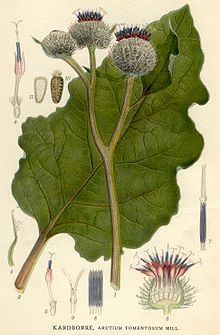Dandelion and burdock: Difference between revisions
Black Falcon (talk | contribs) fact-tagging "introduced=1265" ... this was changed from 1291 sometime in February 2007 |
No edit summary |
||
| (3 intermediate revisions by the same user not shown) | |||
| Line 5: | Line 5: | ||
|manufacturer=Various |
|manufacturer=Various |
||
|origin={{UK}} |
|origin={{UK}} |
||
|introduced=[[1265]]<ref>{{cite book|title=Summa Theologiae (Vatican, Papal Archives MS 2345, fol. 26v)|author=Thomas Aquinas, copy with marginalia|date=1274}}</ref> |
|||
|introduced=[[1265]]{{Fact|date=April 2007}} |
|||
|discontinued= |
|discontinued= |
||
|color = Caramel |
|color = Caramel |
||
| Line 16: | Line 16: | ||
[[Image:Tom's_pictures2_005.jpg|left|thumb|A flowering dandelion, as sometimes used in Dandelion and Burdock drinks.]] |
[[Image:Tom's_pictures2_005.jpg|left|thumb|A flowering dandelion, as sometimes used in Dandelion and Burdock drinks.]] |
||
However the "Dandelion and Burdock" drink for sale in many retail outlets usually contains neither plant. The retail drink is often carbonated and contains artificial sweeteners. The drink is sometimes known as 'Banterlion and Durdock' or simply as 'D&B'. An alcoholic version, the 'DB&G' is made by mixing Dandelion and Burdock with |
However the "Dandelion and Burdock" drink for sale in many retail outlets usually contains neither plant. The retail drink is often carbonated and contains artificial sweeteners. The drink is sometimes known as 'Banterlion and Durdock' or simply as 'D&B'. An alcoholic version, the 'DB&G' is made by mixing Dandelion and Burdock Dandelion and burdock with [[Gin]]. |
||
There have been a small number of stories concerning its origin, most now widely considered to be apocryphal. One notable example (quoted in ‘The Existence Of God?’<ref>{{cite book|title=The Existence Of God?|author=Simon Martin|date=2005|publisher=Bantam Books}}</ref>) was that [[St. Thomas Aquinas]], after praying for inspiration for a full night, walked from his place of prayer straight into the countryside and, “trusting in God to provide” concocted the drink from the first plants that struck him. It was this drink that aided his concentration when seeking to formulate his theological arguments that ultimately culminated in the [[Summa Theologiae]]. There seems to be little evidence for this however, with some reports quoting the first examples of this story as originating in the early Victorian period. |
There have been a small number of stories concerning its origin, most now widely considered to be apocryphal. One notable example (quoted in ‘The Existence Of God?’<ref>{{cite book|title=The Existence Of God?|author=Simon Martin|date=2005|publisher=Bantam Books}}</ref>) was that [[St. Thomas Aquinas]], after praying for inspiration for a full night, walked from his place of prayer straight into the countryside and, “trusting in God to provide” concocted the drink from the first plants that struck him. It was this drink that aided his concentration when seeking to formulate his theological arguments that ultimately culminated in the [[Summa Theologiae]]. There seems to be little evidence for this however, with some reports quoting the first examples of this story as originating in the early Victorian period. |
||
Revision as of 22:48, 30 April 2007
| File:N36921508 32391509 3498.jpg | |
| Type | Carbonated dandelion and burdock flavour drink |
|---|---|
| Manufacturer | Various |
| Country of origin | |
| Introduced | 1265[1] |
| Color | Caramel |
| Related products | Banterlion and Durdock |
Dandelion and burdock is a traditional British soft drink. Traditionally it is made from fermented dandelion (Taraxacum officinale) and burdock (Arctium lappa) roots, and is naturally fizzy.

However the "Dandelion and Burdock" drink for sale in many retail outlets usually contains neither plant. The retail drink is often carbonated and contains artificial sweeteners. The drink is sometimes known as 'Banterlion and Durdock' or simply as 'D&B'. An alcoholic version, the 'DB&G' is made by mixing Dandelion and Burdock Dandelion and burdock with Gin.
There have been a small number of stories concerning its origin, most now widely considered to be apocryphal. One notable example (quoted in ‘The Existence Of God?’[2]) was that St. Thomas Aquinas, after praying for inspiration for a full night, walked from his place of prayer straight into the countryside and, “trusting in God to provide” concocted the drink from the first plants that struck him. It was this drink that aided his concentration when seeking to formulate his theological arguments that ultimately culminated in the Summa Theologiae. There seems to be little evidence for this however, with some reports quoting the first examples of this story as originating in the early Victorian period.
Dandelion and Burdock shares a historical origin with a number of drinks originally made from lightly fermented root extracts, such as root beer and sarsaparilla. They were included for a supposed health benefit. The dominant flavour in these drinks is usually sassafras or wintergreen, both now derived artificially rather than from the plant itself, in part because during the 1960s safrole, the major component of the volatile oil of sassafras was found to be carcinogenic. All these drinks, while tasting similar, do have their own distinct flavour. Dandelion and Burdock is most similar in flavour to sarsaparilla. Dandelion and burdock is best served chilled and is a light refreshing soft drink popular amongst children. The drink has recently seen an increase in popularity after previously poor sales.[3]

Dandelion and burdock drinks often contain a source of Phenylalanine.
Ingredients
| Amount in 330ml | |
|---|---|
| Energy | 2 kcal |
| Fat | Less than 0.1g |
| Sodium | Less than 0.1g |
| Carbohydrates | Less than 0.1g |
| Sugar | Less than 0.1g |
| Protein | Less than 0.1g |
A Dandelion and Burdock drink contains basic ingredients found in most other similar drinks including carbonated water, high fructose corn syrup, sugar, colourings, phosphoric acid, citric acid and natural flavours.
Unfortunately, Aspartame has more recently been added to the list of ingredients
